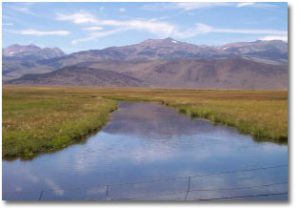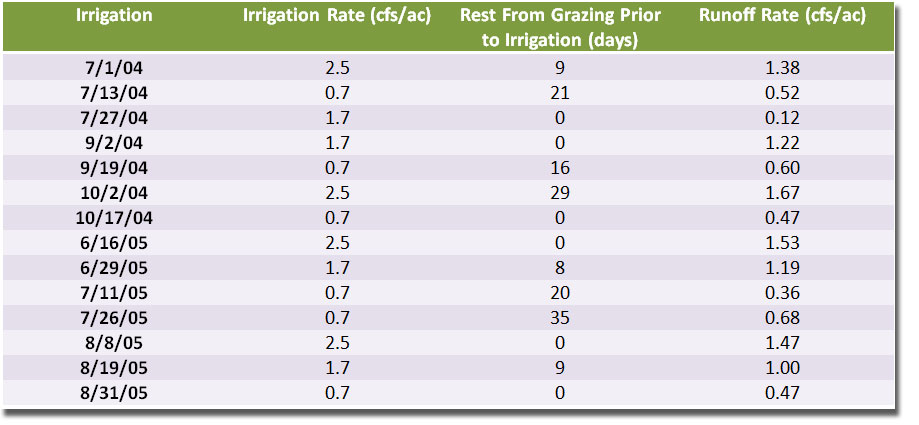Part One: Irrigated Pasture Management to Improve Stream Water Quality
Irrigated pastures in northern and central California provide critical summer forage for livestock. In many cases, water is diverted directly from small streams and transported to pastures for flood irrigation. These stream diversion irrigation systems have the potential to impact downstream water quality by: 1) reduction of in-stream flow volumes; and 2) return of pasture tailwater to the stream, carrying pollutants to the stream. In Tate et al. (2005), we illustrate how to monitor water quality and streamflow response to these pasture systems.
Stream diversion based irrigated meadows and pastures
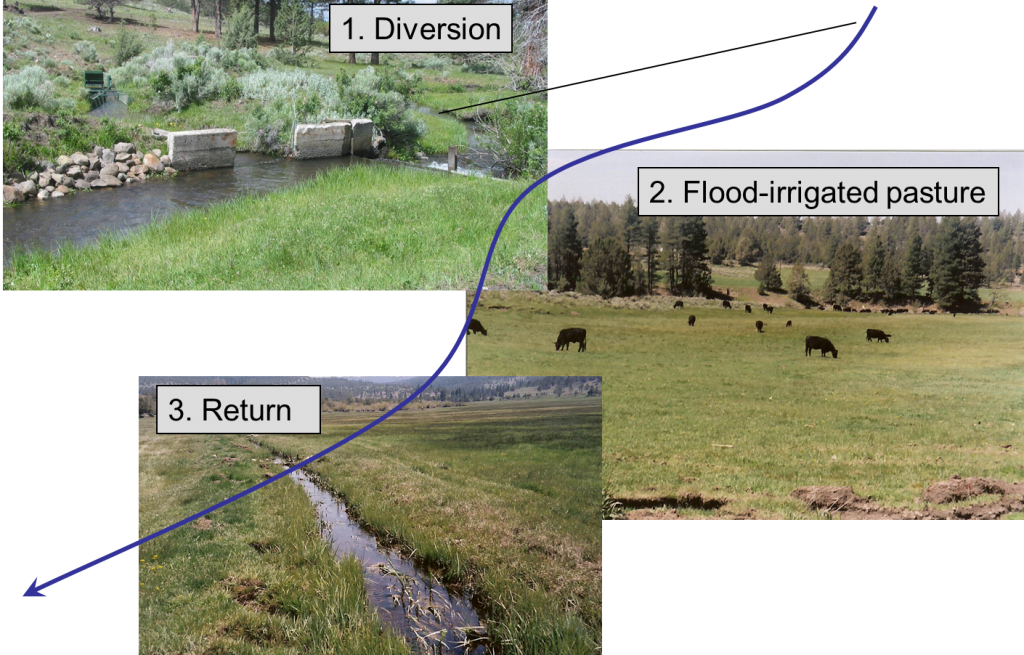
Classic above vs. below monitoring
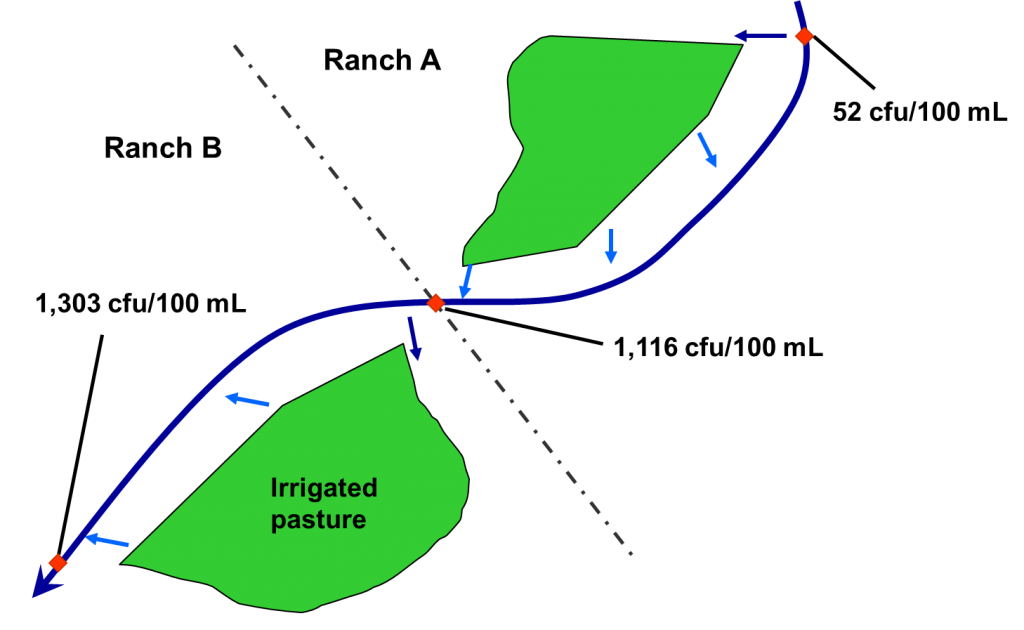
Streamflow is diverted into a ditch and distributed across a pasture. Pasture tailwater is then returned to the stream, or used to irrigate other pastures.
Here, we present the results of a survey of 10 stream diversion irrigated pasture systems in northeastern California. We monitored E. coli concentrations (colony forming units per 100 mL, cfu/100mL) above and below where water was diverted and returned to each of the 10 streams. We documented grazing and irrigation management, so we correlate management to stream water quality.
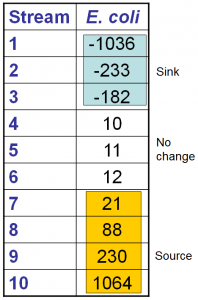
We sampled in-stream E. coli concentrations above and below each pasture system every 2 weeks for the entire irrigation season – April through August.
Not all of the irrigated pastures increased down stream E. coli concentrations. In fact, some actually decreased concentrations. The table below reports the average difference in concentration below compared to above each pasture over the entire summer irrigation season. A negative value indicates that E. coli concentrations downstream were lower than upstream, a positive value indicates downstream concentrations were higher than upstream, and a value of zero indicates no change in concentration.
Average difference in E. coli concentration below compared to above each pasture system ranged from about a 1000 reduction to about a 1000 increase in cfu/100mL.
Pasture 1 was cut for hay and there was no livestock grazing during the irrigation season. In addition, there were relatively high (>1,000 cfu/100mL) E. coli concentration in Stream 1 above the pasture due to up stream pollution sources. Pasture 1 acted as a vegetative filter strip to remove E. coli from the stream. Pastures 2 through 10 were all differentially grazed by livestock (e.g., high to low stocking densities, grazed during irrigation v. livestock removed before irrigation) and irrigated (e.g., at low to high rates of water application). Both grazing and irrigation management effected E. coli concentrations below a pasture. The figures and captions below describe these relationships.
Irrigation Application Rate - Runoff Rate
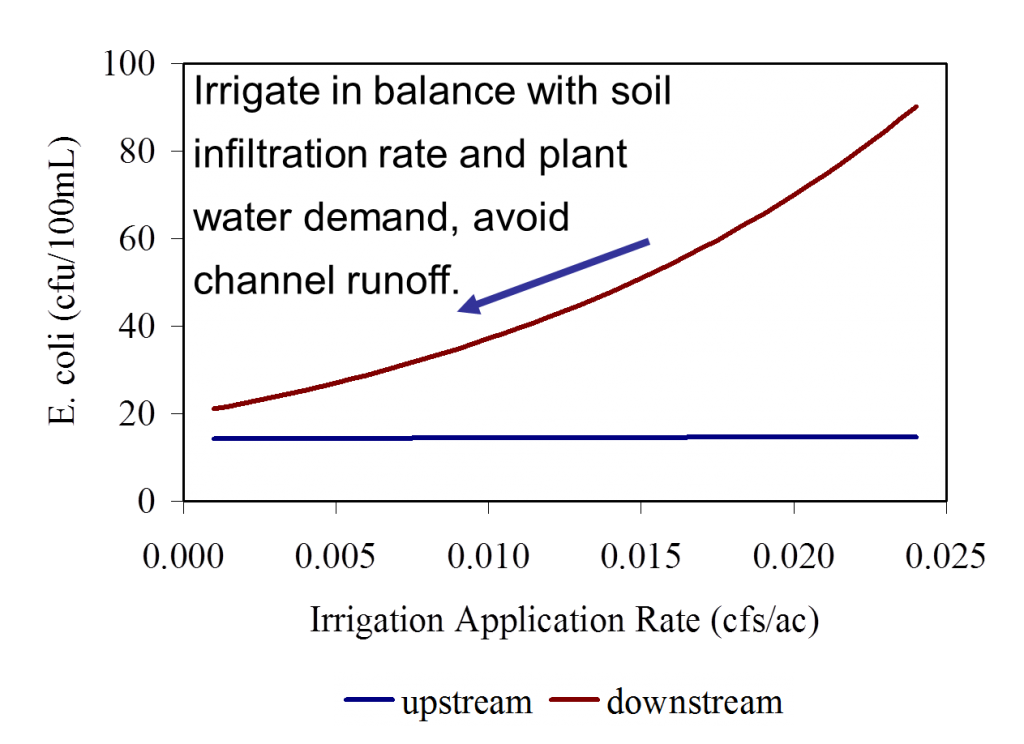
As the rate of irrigation water application to a pasture increased, we observed a significant increase in downstream E. coli concentrations.
Cattle Stocking Density (AU=1 cow)
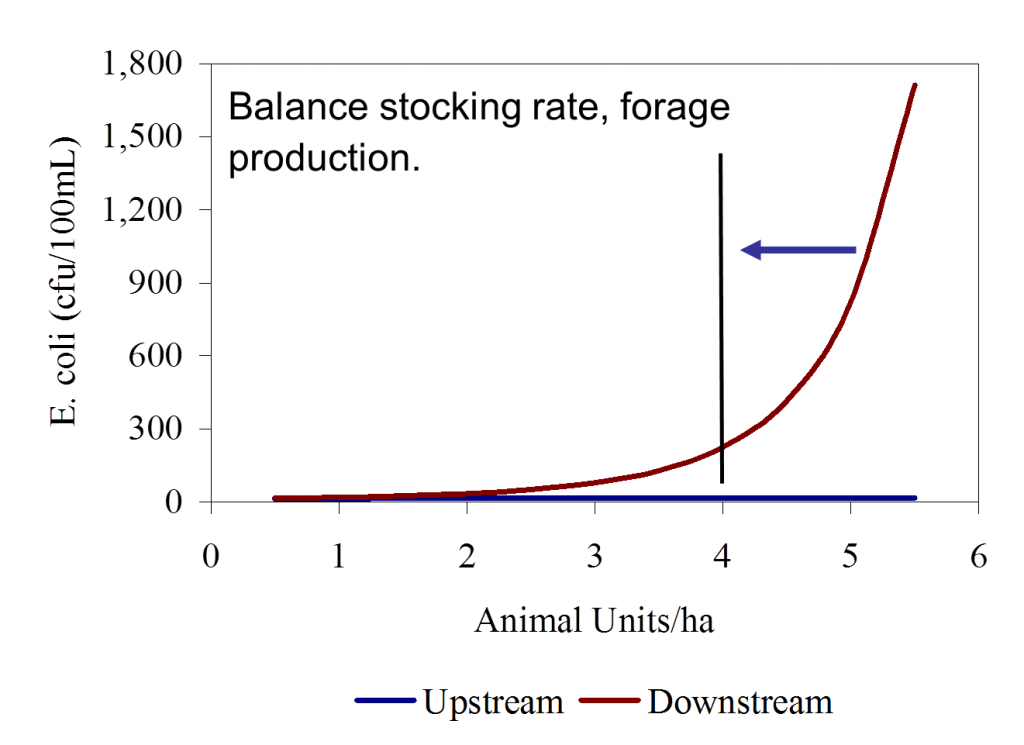
As the density of livestock on a pasture increased, we observed a significant increase in downstream E. coli concentrations.
Rotational Grazing and Diversion Rate
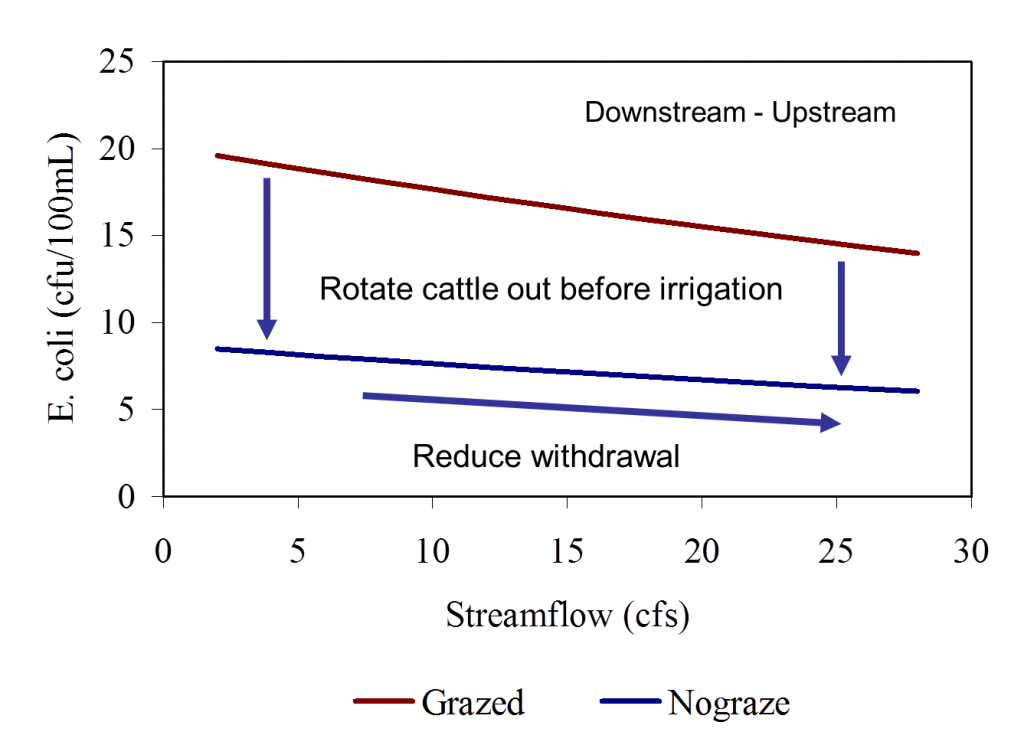
If a pasture was actively grazed during irrigation, we observed a significant increase in downstream E. coli concentrations. Also, as the volume of streamflow decreased, we observed a significant increase in downstream E. coli concentrations.
Management Implications
Stream diversion irrigated pastures can increase in-stream E. coli concentrations, but we found that this was not always the case.
Management that increases down stream E. coli concentrations:
1. high tailwater runoff rates
2. high livestock densities
3. livestock grazing during irrigation events
4. pasture tailwater discharge into low flow streams
Management to reduce downstream E. coli concentrations:
1. moderate livestock densities
2. reduced tailwater runoff rates
3. rotational grazing to remove livestock prior to irrigation events
The management challenges and opportunities are different on each pasture and ranching operation. There is no single best stocking density or irrigation application rate. The pasture manager can reduce water quality impacts by implementing one or more of these management options. The key is to make the effort to moderate stock density, runoff, and timing of grazing relative to irrigation whenever and wherever practically possible.
Supporting Information
Tate, K.W., D.L. Lancaster, J. Morrison, and D.F. Lile. 2005. Monitoring Helps Reduce Water Quality Impacts in Flood Irrigated Pasture. California Agriculture. 59:168-175. Read More
Part Two: Irrigated Pasture Management to Reduce E. coli in Tailwater
We examined the transport of E. coli from a 12 acre flood irrigated pasture to determine how pasture management affected concentrations in pasture runoff. Irrigation was managed to create a range of runoff rates during 14 irrigation events. This allowed us to investigate the potential to reduce E. coli concentrations by reducing runoff rate; thus, reducing erosion of bacteria from cattle fecal pats and flushing of bacteria from the pasture. The timing of grazing by beef cattle was managed to create a range of total days rest between grazing and irrigation of the pasture. This allowed us to characterize the reduction in E. coli in attributable to processes such as mortality of E. coli and drying of fecal pats.
Pasture irrigation and grazing was managed to create a range of runoff and days rest from grazing across 14 irrigation events.
We found that as irrigation runoff increased, E. coli in pasture runoff increased. This was due to increased pollutant mobilization and transport capacity as runoff rate increases. E. coli concentrations were highest when cattle were actively grazing the pasture. E. coli concentration was reduced with increased rest between grazing and irrigation. This was due to: 1) natural mortality of microbes in cattle fecal pats as pat age increases; and 2) the drying of the fecal pat and the formation of a dry shell on the outside of the pat reducing the susceptibility of the pat to erosion by irrigation water flowing across the pasture.
Pasture irrigation and grazing was managed to create a range of runoff and days rest from grazing across 14 irrigation events.
We found that as irrigation runoff increased, E. coli in pasture runoff increased. This was due to increased pollutant mobilization and transport capacity as runoff rate increases. E. coli concentrations were highest when cattle were actively grazing the pasture. E. coli concentration was reduced with increased rest between grazing and irrigation. This was due to: 1) natural mortality of microbes in cattle fecal pats as pat age increases; and 2) the drying of the fecal pat and the formation of a dry shell on the outside of the pat reducing the susceptibility of the pat to erosion by irrigation water flowing across the pasture.
Runoff and Days Rest from Grazing

Irrigation and grazing management can reduce E. coli transport from pastures.
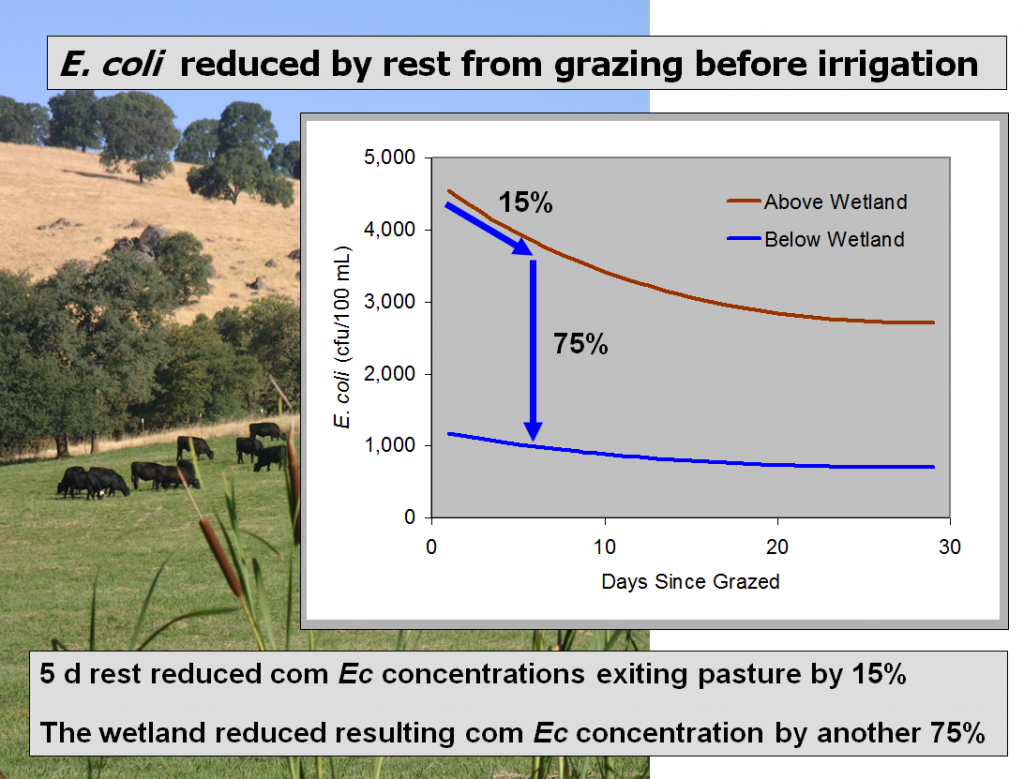
Management Implications
E. coli transport from pastures can be reduced with irrigation management designed to minimize tailwater runoff rate and volume. Significant reduction in E. coli concentration can also be achieved by rotating cattle out of a pasture to allow several days of rest from grazing prior to irrigation.
Supporting Information
Knox, A.K., K.W. Tate, R.A. Dahlgren, and E.R. Atwill. 2007. Management Reduces E. coli in Irrigated Pasture Runoff. California Agriculture. 61:159-165. Read More

